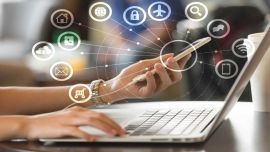Argentina registered inflation of 94.8 percent in 2022 – its highest official annual figure since 1991 and the hyperinflation registered in the late 1980s and at the beginning of the 1990s, the INDEC national statistics bureau confirmed on Thursday.
Latin America's third-largest economy has been suffering from runaway price hikes throughout the year, though December's monthly figure of 5.1 percent continued a general downward trend since a peak of 7.4 percent in July. In the preceding month, November, inflation totalled 4.9 percent.
In a small victory for President Alberto Fernández’s government, the data means that Argentina managed to avoid registering a cumulative inflation rate for last year that ran into three digits. The economy also slightly undershot estimates from the experts – private analysts participating in the Central Bank’s most recent monthly survey of market expectations (REM) had forecast a rate of 5.5 percent for December and an annual rate of 95.5 percent.
Nevertheless, the final figure is a sharp rise on the estimate outlined in the government’s 2022 budget bill of between 52 and 62 percent. And it was a huge jump on the 50.9 percent inflation figure recorded in 2021.
According to this year’s budget proposal, the Fernández administration expects price hikes to total 60 percent in 2023. To that end, they are planning to limit salary increases agreed in collective-bargaining talks to the same figure.
Experts disagree, however, with the latest REM survey forecasting an annual rate for 2023 of 98.4 percent.
For most Argentines, going to the supermarket has long been a disheartening experience.
"You stand in front of the shelves and analyse prices as if you were picking out jewellery," said Julián Rattano, 66, a retired chemist, as he shopped in the capital.
Prices for daily staples rose monthly, even weekly, last year. A litre of milk rose 320 percent in 2022, while cooking oil shot up 456 percent and a kilo of sugar soared 490 percent, the Abeceb consultancy firm says.
Price rises over the last 12 months were steepest in clothing and footwear, at more than 120 percent, and hotels and restaurants, where they jumped a little under 109 percent.
Price hikes in December were led by large increases in sectors including restaurants and hotels (up 7.2 percent) and alcoholic beverages and tobacco (rising 7.1 percent). The most closely watched category, food and non-alcoholic beverages, rose 4.7 percent and had the biggest impact across all regions, INDEC reported, with steep rises for fruits, drinks, breads and cereal.
Household equipment and maintenance costs rose 5.9 per cent, with transport up 5.8 percent and healthcare recording an increase of 5.7 percent.
Coming in under five percent were recreation and culture, which rose 4.6 percent, utilities (4.2 percent), clothing and footwear (four percent) and communications (3.4 percent).
Core inflation was 5.3 percent, with regulated prices up 5.1 percent in the same period, impacted heavily by government-approved increases for fuel and prepaid medical services. Seasonal inflation came in at 4.6 percent.
The largest hikes were recorded in Greater Buenos Aires (up 5.3 percent), with the lowest in Patagonia (4.5 percent).
Fresh reminder
The fresh reminder of Argentina’s inflation woes is bad news for the government, arriving just nine months out from a general election. However, the general slowdown registered since the middle of last year indicates that Economy Minister Sergio Massa is starting to at least tackle the problem slightly.
Still, these are the worst yearly figures since the country recorded an inflation rate of 84 percent in 1991, during the Carlos Menem Presidency that spanned a decade.
The two previous years had seen hyperinflation at more than 2,000 percent. In 1991, Menem launched the convertibility plan, pegging the peso to the US dollar in a bid to tackle hyperinflation. But that move was abandoned a decade later.
Argentina has been grappling with an economic crisis for years, registering double-digit inflation in each of the last 12 years.
Causes of inflation are multiple, including persistent deficit spending, constant devaluation and external factors like the war in Ukraine that affected energy and grain prices.
A result is a baked-in expectation of "systematic increases of prices, tariffs, salaries, rents... according to expectations that are not always solid, sometimes based on fantasy or rumour about future inflation," economist Ricardo Aronskind told AFP.
In a bid to slow inflation, Massa last month reached a new agreement with food and personal hygiene companies to freeze the prices of around 2,000 products until March, capping rises on another 30,000 products to four percent a month.
Argentina's economy grew by around five percent in 2022, compared to a 10.3 percent increase in GDP the previous year, which ended three years of recession.
Growth for 2023 is expected to slow to just two percent, according to the World Bank.
If that does happen, it would be the first time in 15 years that Argentina had experienced three successive years of growth – the economy grew six years in a row from 2003 to 2008.
Wage increases have lagged behind inflation meaning millions of Argentines saw their spending power fall in 2022.
In the early 20th century, Argentina was among the world's better-off countries, attracting immigrants from Europe, especially, Italy, and the Middle East.
Now, a jaw-dropping 36.5 percent of Argentina's 47 million population live in poverty, including 2.6 million in extreme poverty, according to official data from mid-2022.
– TIMES/AFP/PERFIL



















Comments